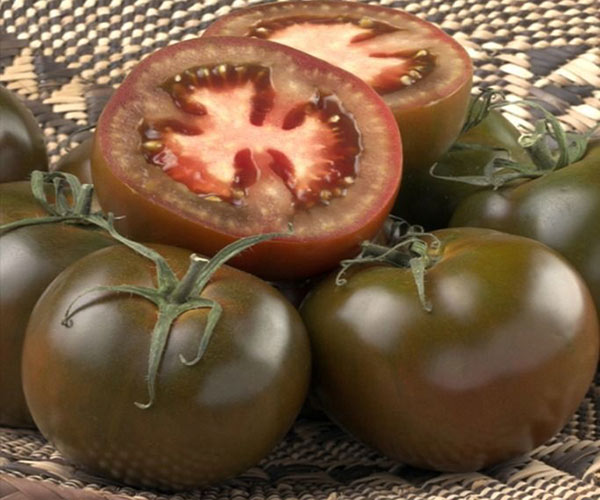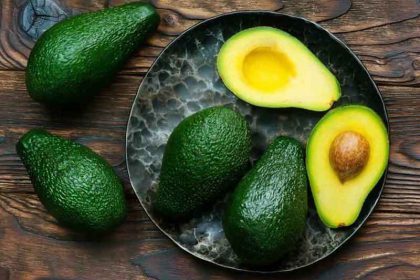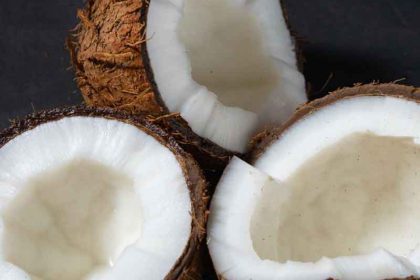Kumato benefits for skin and hair and with loos and male
Kumato benefits
Kumato tomatoes are a variety known for their unique flavor and appearance. While limited scientific research focuses specifically on their skin benefits, they share similarities with other tomatoes. Kumato tomatoes contain antioxidants, such as lycopene, beta-carotene, and vitamin C, which protect the skin from damage and contribute to a healthy complexion. Additionally, the lycopene content may provide some sun protection. Kumato tomatoes are versatile and can be used fresh in salads, sliced for sandwiches, roasted or grilled, used in sauces and soups, oven-dried, or as garnish.
Kumato benefits for skin
Kumato tomatoes, also known as “brown tomatoes,” are known for their unique appearance and flavor. While there is limited scientific research specifically focused on the skin benefits of Kumato tomatoes, they share some similarities with other tomato varieties that are recognized for their potential skin benefits. Here are some general benefits of tomatoes for the skin, which may also apply to Kumato tomatoes:
Antioxidant properties: Kumato tomatoes, like other tomato varieties, contain antioxidants such as lycopene, beta-carotene, and vitamin C. These antioxidants help protect the skin from damage caused by free radicals, which can contribute to premature aging, wrinkles, and skin damage.
Skin hydration: The high water content in Kumato tomatoes can contribute to skin hydration, promoting a healthy and moisturized complexion.
Vitamin C content: Kumato tomatoes are a good source of vitamin C, which is essential for the production of collagen, a protein that helps maintain skin elasticity and firmness.
Skin brightening: The natural acids found in Kumato tomatoes, such as citric acid and malic acid, can help brighten the skin, giving it a more radiant appearance.
Acne prevention: Some studies suggest that the antioxidants and anti-inflammatory properties of tomatoes may help reduce the occurrence of acne and promote clearer skin.
Sun protection: The lycopene content in Kumato tomatoes, a carotenoid pigment responsible for their distinctive color, may offer some protection against sun damage by acting as a natural sunscreen.
what are Kumato tomatoes used for
Kumato tomatoes, with their distinct flavor and appearance, can be used in various culinary preparations. Some common uses for Kumato tomatoes:
Fresh in salads: Kumato tomatoes can be enjoyed raw in salads, adding a unique flavor and color to your dish. They pair well with other salad ingredients like leafy greens, cucumbers, onions, and feta cheese.
Sliced for sandwiches: Kumato tomato slices can be used as a flavorful addition to sandwiches, wraps, and burgers. Their rich and slightly sweet taste adds depth to the overall flavor profile of the sandwich.
Roasted or grilled: Roasting or grilling Kumato tomatoes can intensify their flavor and bring out their natural sweetness. Use them in roasted vegetable medleys, pasta dishes, or as a side dish to accompany grilled meats.
Sauces and salsas: Kumato tomatoes can be used to make flavorful sauces, salsas, and dips. They can be pureed or chopped to create a base for pasta sauces, pizza sauces, or fresh salsas for chips and tacos.
Soups and stews: Kumato tomatoes can be incorporated into soups and stews, adding depth and richness to the flavors. They work well in tomato-based soups, vegetable stews, or as a component in gazpacho.
Oven-dried: Kumato tomatoes can be dried in the oven to concentrate their flavors and create a versatile ingredient. Use oven-dried Kumato tomatoes in pasta dishes, and salads, as a topping for pizzas, or as a flavorful addition to charcuterie boards.
Garnish and decoration: Kumato tomato slices or wedges can be used as a garnish to add visual appeal and flavor to various dishes. They can be added to appetizers, canapés, or used as a decorative element in salads and platters.
Kumato tomato seeds
No, Kumato tomatoes are not genetically modified. They are a hybrid variety that was developed through traditional breeding methods. Kumato tomatoes were created by crossbreeding different tomato varieties to achieve their distinct flavor, appearance, and characteristics. The specific parentage and breeding methods used to create Kumato tomatoes are proprietary information held by the company that developed them. It’s important to note that hybridization is a natural breeding process that has been practiced for centuries to improve desirable traits in plants, and it is distinct from genetic modification, which involves manipulating an organism’s genetic material using modern biotechnology techniques.
Kumato tomato nutrition
Kumato tomatoes, also known as brown tomatoes, are a variety of tomato that offers various nutrients and health benefits. Here is an overview of the nutrition profile of Kumato tomatoes per 100 grams:
Calories: Approximately 18 calories
Carbohydrates: Around 4 grams
Fiber: Roughly 1 gram
Protein: About 1 gram
Fat: Less than 0.5 grams
Vitamin C: Provides a moderate amount of vitamin C, contributing to immune function and collagen production.
Vitamin K: This contains a small amount of vitamin K, which plays a role in blood clotting and bone health.
Potassium: Provides a modest amount of potassium, an essential mineral involved in various bodily functions, including nerve and muscle function.
Antioxidants: Kumato tomatoes contain various antioxidants, such as lycopene, which may have protective effects against certain diseases and promote heart health.
Other Nutrients: Kumato tomatoes also contain small amounts of other vitamins and minerals, including vitamin A, vitamin E, folate, and iron.
It’s worth noting that the nutritional composition may vary slightly depending on the specific variety of Kumato tomato and its ripeness. Additionally, these values are approximate and can differ based on factors such as growing conditions and cultivation practices.
Kumato recipes
Here are a few delicious recipes featuring Kumato tomatoes:
Kumato Tomato Salad: Ingredients:
Kumato tomatoes, sliced
Fresh mozzarella cheese, sliced
Fresh basil leaves
Extra virgin olive oil
Balsamic vinegar
Salt and pepper to taste
Instructions:
Arrange the sliced Kumato tomatoes and mozzarella cheese on a plate. Scatter fresh basil leaves over the tomatoes and cheese. Drizzle with extra virgin olive oil and balsamic vinegar. Season with salt and pepper to taste. Serve as a refreshing salad or appetizer.
Kumato Tomato Bruschetta: Ingredients:
Kumato tomatoes, diced
Fresh basil leaves, chopped
Garlic cloves, minced
Extra virgin olive oil
Balsamic vinegar
Baguette or crusty bread slices
Salt and pepper to taste
Instructions:
In a bowl, combine the diced Kumato tomatoes, chopped basil leaves, minced garlic, extra virgin olive oil, and balsamic vinegar. Season with salt and pepper to taste. Toast the baguette or bread slices. Spoon the Kumato tomato mixture onto the toasted bread. Drizzle with a little extra olive oil if desired. Serve as a tasty bruschetta appetizer.
Kumato Tomato Pasta: Ingredients:
Kumato tomatoes, diced
Garlic cloves, minced
Fresh basil leaves, chopped
Extra virgin olive oil
Pasta of your choice
Parmesan cheese (optional)
Salt and pepper to taste
Instructions:
Cook the pasta according to the package instructions until al dente. In a pan, heat some olive oil and sauté the minced garlic until fragrant. Add the diced Kumato tomatoes and cook for a few minutes until slightly softened. Stir in the chopped basil leaves and season with salt and pepper. Drain the cooked pasta and add it to the pan with the tomato mixture. Toss the pasta to coat it with tomato sauce. Optional: Serve with grated Parmesan cheese on top. Enjoy a flavorful Kumato tomato pasta dish.
Feel free to modify these recipes according to your taste preferences and dietary needs. Kumato tomatoes can be used in various dishes, including sandwiches, wraps, salsas, and more. Get creative and enjoy the unique flavor of Kumato tomatoes in your favorite recipes!
Where to buy Kumato tomatoes
Kumato tomatoes can be found in many grocery stores, supermarkets, and specialty food stores. They are relatively popular and widely available in many regions. Here are a few places where you may be able to purchase Kumato tomatoes:
Local grocery stores: Visit your nearest grocery store or supermarket and check their produce section. Kumato tomatoes are often stocked alongside other tomato varieties.
Farmers markets: Check out local farmers’ markets in your area. Farmers’ markets often offer a wide selection of fresh produce, including specialty tomatoes like Kumato.
Specialty food stores: Specialty food stores or gourmet markets that focus on high-quality and unique ingredients are more likely to carry Kumato tomatoes. These stores may have a wider range of tomato varieties compared to regular supermarkets.
Online grocery stores: Many online grocery retailers now offer a wide selection of fresh produce, including specialty tomatoes. You can search for Kumato tomatoes on popular online grocery platforms and have them delivered to your doorstep.
Seed catalogs: If you enjoy gardening and want to grow Kumato tomatoes yourself, you can purchase Kumato tomato seeds from seed catalogs or online seed suppliers. This allows you to grow your own Kumato tomatoes at home.
Kumato vs tomato nutrition
Kumato tomatoes and regular tomatoes have similar nutritional profiles as they both belong to the same family. Here’s a comparison of their nutrition per 100 grams:
Kumato Tomatoes:
Calories: 48
Carbohydrates: 10.4 grams
Protein: 1.6 grams
Fat: 0.2 grams
Fiber: 1.6 grams
Vitamin C: 14 milligrams (23% of the recommended daily intake)
Vitamin A: 833 international units (17% of the recommended daily intake)
Potassium: 429 milligrams
Lycopene: 3.7 milligrams
Regular Tomatoes:
Calories: 18
Carbohydrates: 3.9 grams
Protein: 0.9 grams
Fat: 0.2 grams
Fiber: 1.2 grams
Vitamin C: 13 milligrams (22% of the recommended daily intake)
Vitamin A: 833 international units (17% of the recommended daily intake)
Potassium: 237 milligrams
Lycopene: 3 milligrams
Both types of tomatoes are low in calories and fat while providing essential vitamins and minerals. They are a good source of vitamin C and vitamin A, which are important for immune function and vision health, respectively. Additionally, both Kumato tomatoes and regular tomatoes contain the antioxidant lycopene, which has been associated with various health benefits.
The main difference between Kumato tomatoes and regular tomatoes is their taste and appearance. Kumato tomatoes tend to have a sweeter and more intense flavor compared to regular tomatoes. They also have dark brown or reddish-brown skin, which gives them a unique appearance. It’s important to note that nutritional values can vary depending on the specific variety, ripeness, and growing conditions of the tomatoes.






















